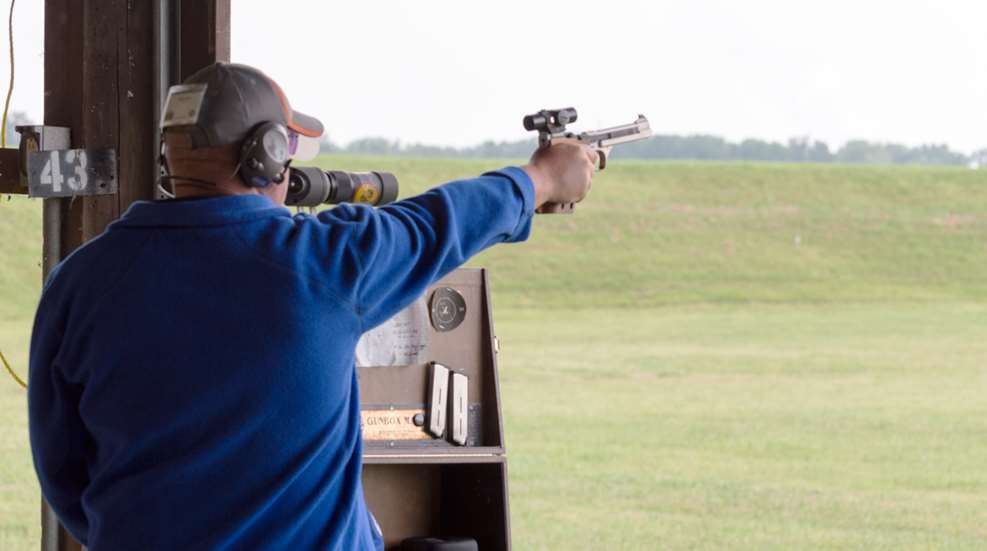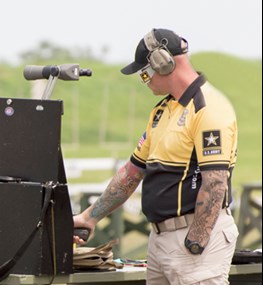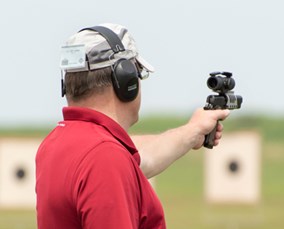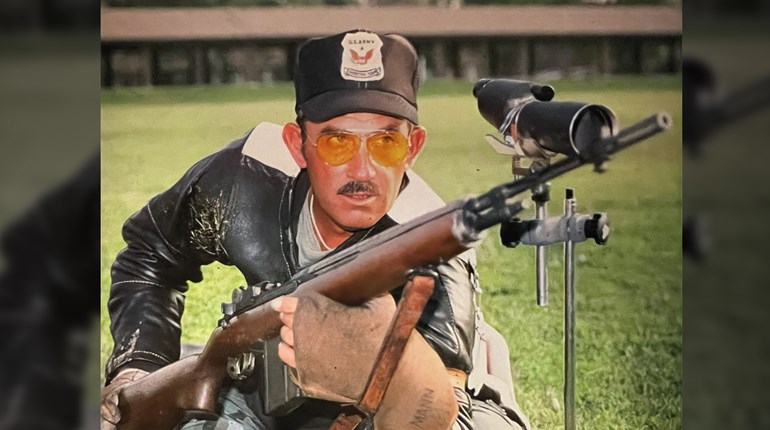
In his latest article for SSUSA, twelve-time NRA National Pistol Champion Brian Zins shares his advice on fixing a bad sustained fire string in precision pistol competition. Zin’s insights are especially valuable because he doesn't always follow the old traditions with his technique. If you are just joining in, you should read his previous articles on trigger control, proper pistol grip, aiming red dot sights and anticipation during competition.
Sustained fire in precision pistol shooting has to be one of the toughest things to master. Most shooters have heard the saying, “Win a match on the long line and lose in the short line.” This is very true, and fixing a bad sustained fire string comes into play with this phrase.
Imagine this: You just shot your personal best in slow fire, all of a sudden you get to the short line, and now you can’t seem to hold the sights or dot steady to save your life. Maybe it’s your nerves or you are over thinking what you are doing? Perhaps not enough confidence in your ability to back up what you just did on the long line?
Shot Process
Once you have developed well thought out, tried, tested and confirmed Shot Process for slow fire, it’s the same process that you will use for sustained fire. The difference is now we use the commands for the sustained fire string to determine when we start the process. Simply take your tried and tested slow fire process, and determine where in the commands you plug it in. Don’t change anything about the process. Have a friend call commands for you, inhale normally, and raise the gun up exhaling as you settle in—as if you were shooting slow fire. Continue to apply the process and start the trigger movement as everything starts to settle—not waiting for perfect sight picture or for the target to face. DO NOT stop. Let the shot go even if there is no target present yet. You can also do this several times in dry fire to avoid burning through a bunch of ammo.
Simply take your tried and tested slow fire process, and determine where in the commands you plug it in. Don’t change anything about the process. Have a friend call commands for you, inhale normally, and raise the gun up exhaling as you settle in—as if you were shooting slow fire. Continue to apply the process and start the trigger movement as everything starts to settle—not waiting for perfect sight picture or for the target to face. DO NOT stop. Let the shot go even if there is no target present yet. You can also do this several times in dry fire to avoid burning through a bunch of ammo.
You may not know it but learning has just occurred. You brought the gun up too early in the commands. Bring it up a little bit later. If the target turns before you have begun to settle and started moving the trigger to the rear, you have initiated the process too late in the commands.
Once after a match, a young Marine Corps Team shooter approached me and said, “I was watching you shoot and like clockwork, from the time the gun leaves the bench and you fire a slow fire shot it is always between 6 and 8 seconds—every time.”
He asked me if I was timing the shots, or if it just worked out that way. The truth is it just works out that way. If the shot gets sent down range and I didn’t abort the shot, it is very close to the same amount of time—every time. Why? Because of the Shot Process.
Watch competitors on the line shooting slow fire, and then watch them when they shoot sustained fire. In slow fire, the gun is raised and starts to settle and they let the shot go. In sustained fire, the gun is raised, the gun settles and practically stops moving, but what happens? They sit there looking at the sights waiting for the target to appear. What are they waiting for? Confirmation that the sights are lined up on the center of the target. If you have a solid position, stance, and grip and dry fired before the sustained fire string started you have already confirmed that. Dry fire more, and trust your position and your hold, so that you can start moving the trigger to the rear before the target moves.
The First Shot
We want to get that first shot to break as soon as possible, so that we have more time to recover and apply the process to the four remaining shots. Four shots in nine seconds sounds a lot better than five shots in 10 seconds. You want the shot to break in accordance to where you are in the process and your application of the fundamentals, not because all of a sudden there is a target in front of you.
When we react to the target turning, we are more apt to jerk the shot out of the trigger instead of allowing the shot to break, because the finger has reacted to what the eye sees. In this case, the finger is reacting to the eye seeing the dot or the iron sights starting to stabilize on the edge of the target where the bullseye is about to appear. Not waiting for the sights to be in the middle when the target appears. When that happens, you will force the shot off and where you thought the sights were when you jerked the trigger is not where they are going to be when the bullet exits the barrel. Ultimately putting a hole in the paper in a less than desired location.
We see that and we react to that first shot, usually not in a positive way. We try to fix it, and become fixated on the first shot. Next thing you know you start to think about time running out.
What happens now? We send four quick shots down range, because we were more concerned about getting them out of the gun—as opposed to making well-aimed shots. After the last shot is fired, we often stand there looking at our target thinking there was plenty of time. Therefore, remember the key word you developed in your slow fire process, because it will help you get back into the sustained fire string without causing panic and worry about running out of time. However, you only say the key word at the start when you raise the gun off the bench and start to settle and then when you run into trouble in the middle of a string of fire—NOT every shot. If you use it for every shot in sustained fire the word begins to lose meaning. The key word is also used to reboot the shot process when things go bad, thus not allowing a bunch of crazy bat crap thoughts to run through your mind because then you start worrying about running out of time, and all the fundamentals go right out the window.
Therefore, remember the key word you developed in your slow fire process, because it will help you get back into the sustained fire string without causing panic and worry about running out of time. However, you only say the key word at the start when you raise the gun off the bench and start to settle and then when you run into trouble in the middle of a string of fire—NOT every shot. If you use it for every shot in sustained fire the word begins to lose meaning. The key word is also used to reboot the shot process when things go bad, thus not allowing a bunch of crazy bat crap thoughts to run through your mind because then you start worrying about running out of time, and all the fundamentals go right out the window.
Recently a shooter emailed me and mentioned what I had talked to him about was sinking in. He added that now he may just need to spend some time working on his timing in question. My response was—“NOO.”
It cannot be overemphasized how important it is to watch people shoot. Watch the relays before or after yours. Pick out one person who shoots well, not great. Watch them shoot sustained fire and pay close attention to their, and I hate even saying this word, cadence. Then, if you have the chance, watch a really great shooter such as Jim Lenardson, Jim Henderson, Keith Sanderson, Phil Hemphill or Steve Reiter.
At that point, make sure you walk down range and take a look at the targets of the good or okay shooters, compared to those of a great shooter. You will find that the better the shooter, the worse the cadence tends to sound as compared to a not so great shooter. Typically the lower the score, the better the cadence. Why is that? It’s because they are more concerned with getting all their rounds off in the allotted time frame, rather than making them well-aimed shots.
Once at the Regional in Canton, OH a gentleman approached me after I had shot what turned out to be a pretty good center fire 900. He said, “I was watching you shoot timed fire and you have no cadence.”
I simply replied, “Thank you,” and walked away. I had shot a 100-10X and a 100-8X.
Conclusion
The point is when shooting sustained fire, who cares what it sounds like? The goal is to get all five shots off and make them as well-aimed shots as possible, right? Now I have shot good strings that sounded like a perfect 5-shot cadence—bang … bang … bang … bang … bang, which are rare. I have also shot good strings that sounded more like a monkey playing a snare drum with a rat a tat tat sound.
Why is that? It’s due to the string with the good cadence, and yes ultimately that is what we are striving for. In the not so good sounding string which was probably an even better score or group, I was working for it. Things didn’t look good and when things don’t look good the first thing to stop is the trigger finger because the mind goes into overload if in fact we are not trying to achieve that perfect sounding cadence. For many people, they simply see black somewhere beyond the end of the gun, so they keep pulling the trigger and hoping for the best.
Remember, in slow fire when things don’t look good we stop the movement of the trigger and abort the shot and start over. That is a luxury we do not have in sustained fire. We see an indicator, either before the shot, during the shot or in recoil following the shot and think to yourself, “Well that was kind of ugly.”
Instead, simply repeating our key word that we used to initiate the shot process will get us back on track. The key word will continue fixing whatever it was that went bad. Do we have to say our key word every single shot? That is a possibility, but it should not occur every shot during a string of sustained fire.
For more tips from Brian Zins, or if you are interested in his training classes, please visit his web site at www.brianzins.com.

































